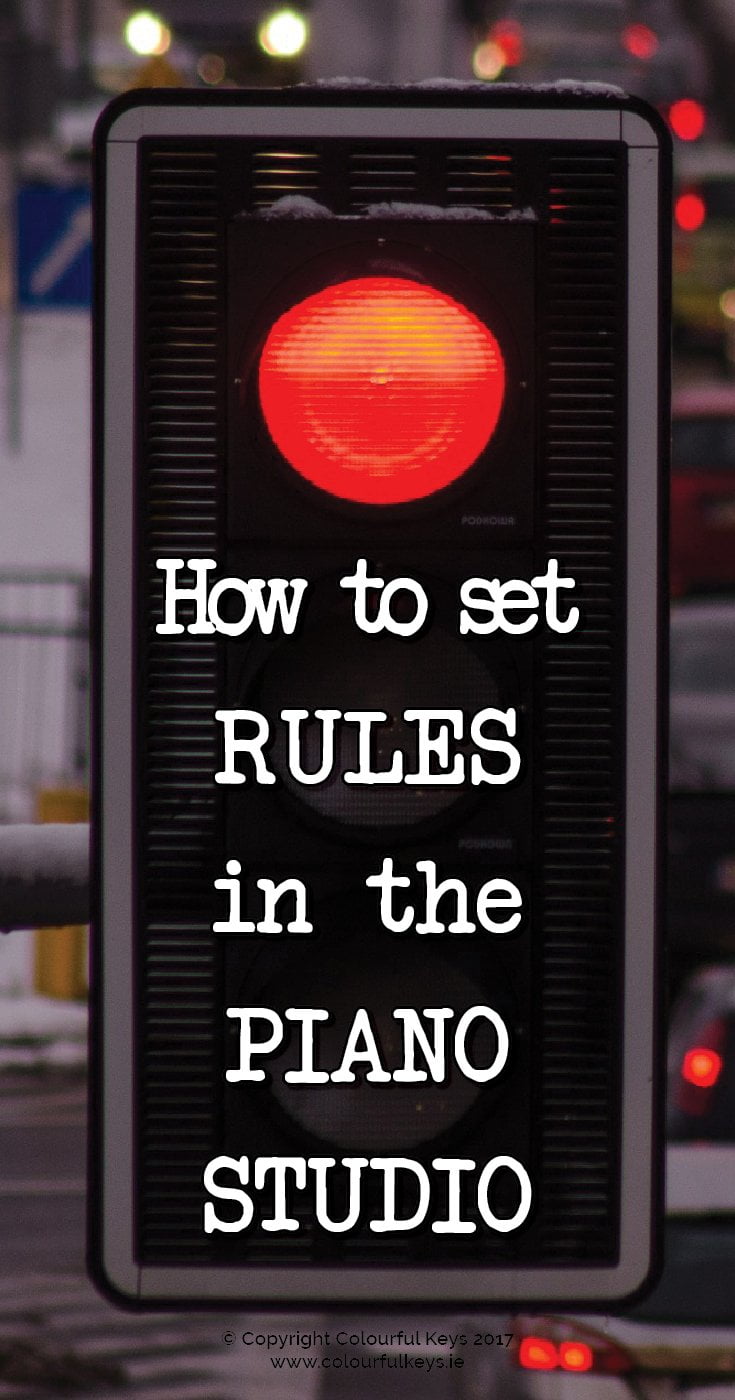Piano studios usually have looser rules than school classrooms. We get to be a little more flexible because we have less students to redirect – often we’re working one-on-one.

However, sometimes you will have a student that takes it too far.
This student just doesn’t follow your directions. She ignores you, bangs on the keys, kicks the piano and goes more than a little off topic.
When this is becoming a worryingly regular occurrence, you need to change tack. You need to find a way to manage this behaviour, so that you can do the part you actually enjoy – teaching piano.
Find the Source
First of all, I think it’s important to think about where this behaviour is coming from. Kids may seem totally random – but they’re actually pretty straight-forward.
Sure she has personality tendencies that you don’t know yet if you just started working with her.
But that bench rocking is likely to be one of these three things:
- A test: The piano studio is a new environment and she wants to find out where the boundaries are here.
- Nervousness: She might be self-conscious or uncertain of this whole piano thing – she’s only saying “no” because she’s worried she’ll get it wrong.
- Rebellion: Mum or dad made this decision for her and she’s using it as an opportunity to assert her independence. (This is the hardest one to deal with but we’ll find a way!)

Have a little think about which your student’s motivation before reading on. What is the source of her acting out?
(There is of course one more possible root cause, which is that your student has a learning difficulty or special need that makes it very difficult to follow your directions. Make sure to ask this on your enrolment forms so you can plan appropriately. Then read this comprehensive post to help you with your piano students with special needs.)
1. Parents In
The parents are the first and foremost symbols of discipline (for want of a better word) for most children. For some kids, having their parent there can suddenly transform their behaviour.
I especially encourage you to try having the parents sit in on lessons if you suspect that your student’s behaviour is a test of your boundaries. She’ll know from her parent’s rules already, so that might help.
Also pay attention to the parent’s reactions and if they intervene or chat with her about behaviour after the lesson. This might reveal good ways to address her behaviour in the studio too.

Subscribe to the newsletter and get the defiant student cheatsheet
Enter your details to subscribe to the newsletter for piano teachers with information, tips and offers.
I hate spam as much as you do! I will only send you emails related directly to piano teaching and you can unsubscribe at any time.
Vibrant Music Teaching members, you can access this resource inside the VMT library. Not a member yet? Find out more about becoming a member here.
2. Parents Out
While a parent’s presence can help – more commonly I find students will behave better without their parents there.
You might find that your student sees you as more of a formal teacher figure when her parent isn’t around. My guess is that this makes it more clear that this is more school than playdate.
Whatever the reason, I’ve seen many students transform into compliant angels when their parent sits in the car instead.
Make a suggestion to try it for a month if your student’s parent is currently sitting in. You can always have mum or dad come in for the last few minutes to talk through practice and still get the benefits of parent participation.
3. Rule Time
Most of us piano teachers don’t set rules the way classroom teachers do. There isn’t usually a need for a formal list or a lecture on how to behave.

However, some students will benefit from a clearly laid out list of rules. This could be a simple as:
- Hands in your lap when I’m talking.
- Feet on the footstool when sitting at the piano.
- Ask me before you play with anything in the studio.
Think about the key misbehaviours that you want to address first and make a list of 3-5 rules – the shorter the better.
Now for the most important step. Once you have your list you should review and discuss it with your student at the start of every single lesson away from the piano.
I like to sit facing the kiddo on our floor cushions. You could do this is the waiting room, at the games table or just standing before you do your warmups. Just don’t do it at the piano!
These rules should be like a refresh button. Don’t talk about what they did before, that’s all been erased. These rules are not punishment for the last lesson. They’re just general rules for your studio.
Now you have a reference point. You can refer to your established rules whenever they’re broken.
The rules will be broken as they forget and/or test if you really mean it. Simply keep reiterating them and calmly correcting the behaviour before returning to your planned lesson content.
4. Structure
Predictable structure can do wonders for managing behaviour. Most kids don’t actually like surprises – even tiny little surprises.
Talk through your structure at the start of each lesson (and keep it the same) and you might see a marked change in cooperativeness over time.
Put this lesson structure in clear view. For reading age children it might be a bulleted list, and for younger children you can use drawings or pictures to represent lesson activities.
Top tip: When you’re planning this format put the child’s favourite activity last. Then if you don’t get to it because she couldn’t follow the directions – you have something to point to.
Download this Article to Read Later
Would you prefer a pdf that you can notate, read back and save for emergency piano student behaviour moments? Enter your details and I’ll send you a printable version.

Subscribe to the newsletter and get the defiant student cheatsheet
Enter your details to subscribe to the newsletter for piano teachers with information, tips and offers.
I hate spam as much as you do! I will only send you emails related directly to piano teaching and you can unsubscribe at any time.
Vibrant Music Teaching members, you can access this resource inside the VMT library. Not a member yet? Find out more about becoming a member here.
5. Small Choices
If you suspect a rebellion, some autonomy might be just the ticket.
Go about this the wrong way, and you might just escalate said rebellion. You want to give choices, without giving away control.

You can do this by following these guidelines:
- Only give two options – this or that – never a list.
- Students decide the order, not the actual content.
Done this way you can give your student a sense of freedom, while still holding the reins firmly in your own hands.
6. Stickers
Have I saved the most obvious for last? Sort of…
The thing is, we all have a tendency to react against these challenging behaviours in big ways, when sometimes the littlest things could do the trick.
Whatever it is you want to motivate your student to do add a sticker chart to her assignment sheet or folder for each lesson.
Pick one top priority to target with your chart. For example, I’ve done this by adding a simple lesson plan to my fishy assignment sheets. Maybe you want to give your student a sticker for every 5 minutes she sits on the bench without falling off.
Whatever you choose – be sure to pick some fun sparkly stickers, preferably in her favourite colour. 😉
Got any behaviour management tricks?
I definitely don’t have all the answers on this! What has worked for you? Have you found any magic solutions?

Thank you, Nicola! This was great! You may remember addressing my query in the IC about a little boy who was causing me great grief. Things are better, but not perfect. Even if I do not use these ideas, they primed my brain. I already promise him the opportunity to play on my Ipad for the last few minutes if things go well. I think I will talk to him this week about a visual addition to the process. I’m not sure what I will use, but 3 “things” that I place where he can see them and each time he breaks a “rule”– playing while I am talking, saying no to a request, etc– I will remove one of the “things”. When he hits 0, he loses the IPad time. Mom is now sitting in lessons and is totally on board with me enforcing good behavior in whatever way I can.
Sounds like a good system Ronda, glad things are going a little better since you sought help in the IC. And it’s wonderful that you have mum on board, that should make a big difference in the long run.
I love the chance cards Jen Fink has on pianimation.com. The reward at the end if they met the expectation for the card they pulled could be a game, a quick app activity, small treat or prize depending on the student. I found a jellybean machine at the thrift store that I use periodically and students love to insert a coin and turn the knob even if just a few candies come out.
heidispianonotes
Love that idea Heidi!
Great idea Heidi!